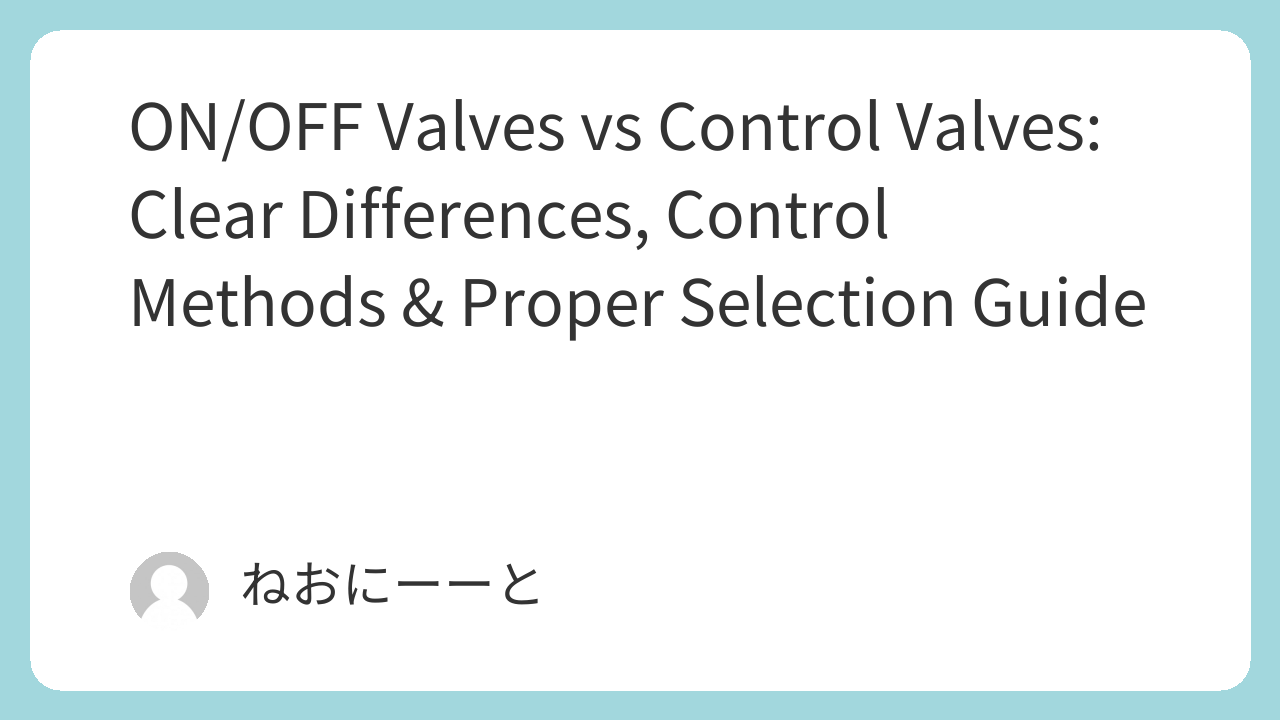As automation advances in chemical plants, understanding the difference between ON/OFF valves and control valves (regulating valves) is essential—not only for instrumentation engineers but also for mechanical and operations teams. Correct valve selection and usage directly impact plant safety, reliability, and performance. In this article, we offer a beginner‑friendly breakdown of key types, operating modes, and selection criteria to confidently determine when to use each.
- 1. Basic Definitions
- 2. Valve Types & Typical Applications
- 3. Valve Trim: Seats, Ports & Leakage Considerations
- 4. Actuation Modes: Direct vs Reverse Acting (DA / RA)
- 5. Fail‑Safe Behaviors When Air Supply Fails
- 6. CV (Flow Coefficient) & Control Performance
- 7. Solenoid Valves for Control Signal
- 8. Pneumatic Cylinder Types & Installation Tips
- 9. Accessories for Control Valves
- Summary
1. Basic Definitions
- ON/OFF valve: Only performs full open or full closed actions; manages on/off flow control.
- Control valve (regulating valve): Varies its opening to control flow rate or pressure continuously.
2. Valve Types & Typical Applications
- Ball valve: Widely used for process isolation and shutdowns.
- Butterfly valve: Common in powder or large‑diameter lines; often automated.
- Gate valve: Typically used in large utility lines; rarely actuated.
- Globe valve: Frequent in regulation applications due to fine throttling.
- Throttling (e.g. Saunders) valve: Similar to globe valves, used frequently in batch control.
3. Valve Trim: Seats, Ports & Leakage Considerations
- Single‑seat vs double‑seat designs: Single‑seat offers minimal leakage; double‑seat handles high differential pressure.
- Port size (full port vs reduced): Full port (e.g. ball, gate) avoids internal restriction; reduced port (butterfly, globe) may require sizing attention.
4. Actuation Modes: Direct vs Reverse Acting (DA / RA)
- Direct Acting (DA): Valves open or close in response to control input aligned with SV‑PV direction.
- Reverse Acting (RA): Opposite response; commonly used in heating or cooling control loops.
- DA/RA combinations apply separately to actuator and valve trim; proper pairing is critical for safe control behavior.
5. Fail‑Safe Behaviors When Air Supply Fails
- Actuators must default to a known, safe position (open or closed); choice depends on process safety requirements and DA/RA configuration.
6. CV (Flow Coefficient) & Control Performance
- CV value defines capacity:
Q=CV×ΔPQ = CV × \sqrt{ΔP}Q=CV×ΔP - Proper valve sizing ensures effective control within the ideal valve travel range (typically 20–80%).
- Control valves often have smaller nominal size than piping and may require reducers or bypasses when corrosion-resistant materials are needed.
7. Solenoid Valves for Control Signal
- 2‑port: Simple on/off control of pneumatic actuator.
- 3‑port / 5‑port: Enable fail positions and dual‑acting cylinder control.
- Proper port configuration is essential to ensure actuator response and reliability.
8. Pneumatic Cylinder Types & Installation Tips
- Single‑acting cylinders with spring return are common for ON/OFF valves.
- Double‑acting cylinders allow position holding but require more complex port/manifold arrangements and support for actuator alignment.
9. Accessories for Control Valves
- Positioners: Translate input current or pneumatic signal into accurate actuator movement.
- Speed controllers: Add resistance to exhaust ports to slow valve movement—support smooth opening/closing in applications like jacket drainage or steam discharge.
Summary
ON/OFF valves and control (regulating) valves serve distinct functions in plant automation. ON/OFF valves manage binary flow states (open/close), while control valves enable continuous modulation of flow or pressure. Proper selection involves evaluating valve type, trim design, port size, acting mode (DA/RA), fail‑safe configuration, CV sizing, and actuation technology. With this knowledge, engineers across disciplines can better support safe, efficient plant operations.

Comments